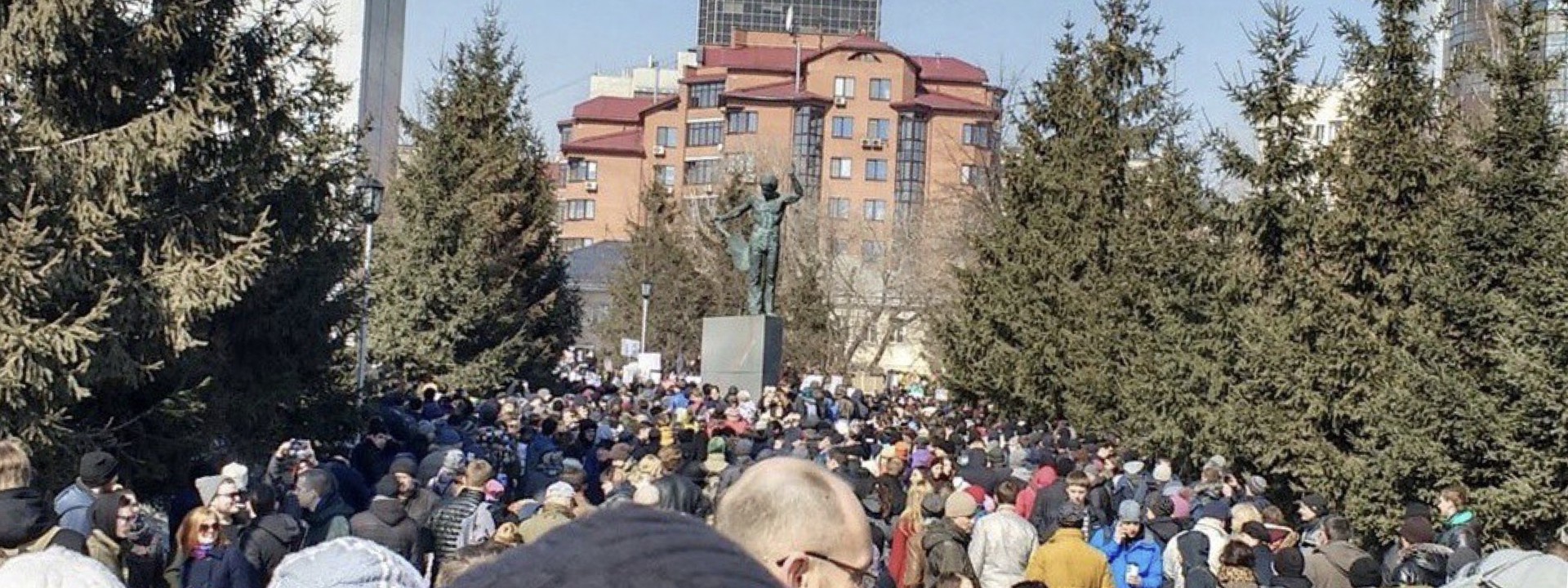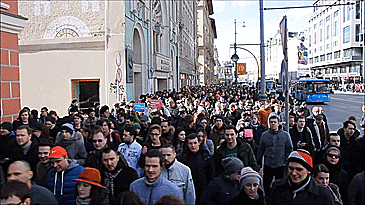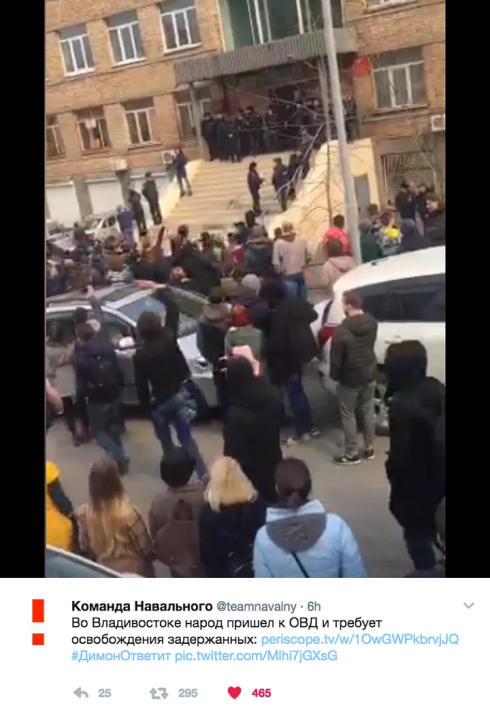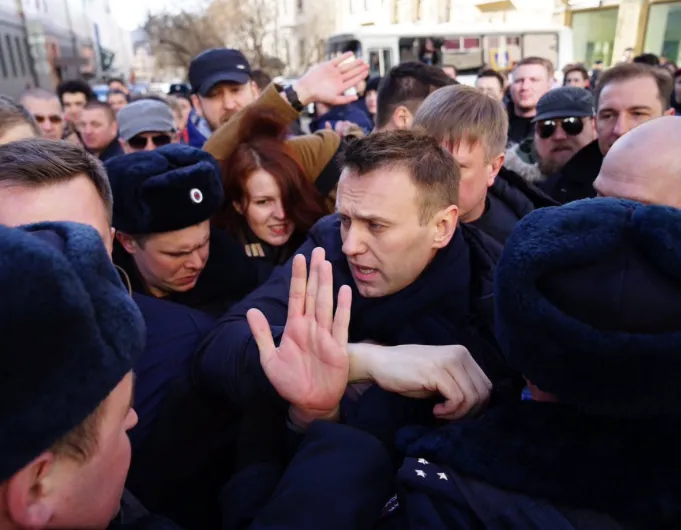Eleven time zones of protests
An open source snapshot of the anti-corruption demonstrations across the world’s largest country
Eleven time zones of protests
Share this story

BANNER: Source: Navalny.com. Demonstrators in Novosibirsk.
On March 26, Russians in almost 100 cities took to the streets to protest against the corruption of senior officials, with a focus on Prime Ministry Dmitry Medvedev. Much of the media coverage has focused on events in Moscow and St Petersburg; this post will look at the broad sweep of demonstrations across the world’s largest country.
Protesting corruption
The protests, many without official sanction, were inspired by opposition blogger-turned-politician Aleksey Navalny’s documentary “Don’t call him Dimon”, which accused former president and current Prime Minister Dmitry Medvedev of a web of corruption totaling hundreds of millions of dollars.

Navalny’s documentary has been viewed over 12 million times and has had great resonance in Russia. To build momentum, Navalny called for nationwide protests against the corruption of senior government officials and to demand Medvedev’s resignation.
On social media the protesters used the hashtags #ДимонОтветит (Dimon will answer) and #ОнНамНеДимон (He’s not Dimon to us). “Dimon” is a diminutive form of “Dmitry” used as a nickname for Medvedev; in Russia, the hashtag refers to Navalny’s expose of his corruption.
The demonstrations, and the official responses to them, varied in scale and intensity. What is perhaps most significant is the number of cities involved, and the focus on corruption. Large opposition demonstrations are sometimes limited to Russia’s largest urban centers of Moscow and St. Petersburg; however, on this occasion, the demonstrations were more of a nationwide movement, with protests held in Vladivostok, in the far east, Murmansk, in the far north, and Makhachkala in the south.
From sea to shining sea
The protests started in Russia’s far east, in Vladivostok, where according to RFERL, a thousand people came out to the streets, and thirty were detained.
In response to the detentions, protesters went to the Vladivostok police station to demand their release:

As seen on Google Street View, the building in the Twitter image is the police department of the Frunzenskiy District of Vladivostok, at Posyetskaya St. 37 (43.115756, 131.880686):

Further protests rolled out across the country, passing from one time zone to the next.
In Novosibirsk, Russia’s third most populous city with a population just under 1.5 million, organizers claimed that approximately 4,000 people joined the rally.

The number of demonstrators should be treated with caution. News station Sib.fm put the number at “over 2,000”, according to one of its own correspondents on the scene. However, the Navalny campaign published photos of the gathering showing a sizable crowd:

The statue in the center back of the photo is of musician Vladimir Vysotsky, in central Novosibirsk (55.025931, 82.927071). We can compare the scene with one from Google Street View, showing the Vysotsky statue:

The rally was peaceful, with no arrests reported. Organizers contrasted this with the events in Moscow, almost 3,000 kilometers to the west.

In Chelyabinsk, 1,500 kilometers further west, hundreds again took to the streets, reportedly shouting “Putin is a thief!” and “Down with corruption!”

The blue tower in the background is the Chelyabinsk City Business Center, at Kirova 159 (55.164655, 61.401299). We can drill down the location to Kirova 85 with a Google Street View comparison, looking southward:

In Murmansk, in the far north, organizers shared photos of a crowd apparently several hundred strong. This rally took place at the Park of the Victims of the Intervention (68.972842, 33.075838), as seen in the Google Street View comparison showing the same buildings.


Protests were also held in the far south of Russia, in Makhachkala, the capital of Dagestan. These demonstrations were less peaceful: 156 people were reportedly arrested, and activists shared imagery of police confronting demonstrators.

The organizers attributed the figure of 156 detainees to a police source; they added that three journalists had been arrested, naming them as Sergei Rasulov of Kommersant, Vladimir Sevrinovskiy of Eto Kavkaz, and Faina Kachabekova of Kavkazkaya Politika. The latter outlet confirmed online that its correspondent was later released, and corroborated the names of the two other detained journalists.
According to Kachabekova’s account, the journalists were questioned separately, and were asked their reasons for attending the demonstration and whether they had been carrying banners or placards. By 18:00 local time, police sources said that around 40 detainees remained in custody.
The largest crackdowns, however, took place in Moscow. Ahead of the protests, a video of hundreds of policemen being deployed in preparation was shared on social media:
Kommersant later posted numerous photos of the police going into action, bearing individual protesters to the ground and dragging them away. The newspaper quoted police sources as saying that up to 8000 people had taken part in the Moscow demonstration.
Twitter users shared their images of the demonstrations:
Pushkin Sq in central Moscow as unsanctioned Navalny anti-corruption rally gets underway: pic.twitter.com/m6vpYa6wzV
— Howard Amos (@howardamos) March 26, 2017
Стрім з Москви, де люди зібралися на антикорупційну акцію #ДимонОтветит https://t.co/tkVRs6ONLk pic.twitter.com/7GsDusNbFR
— Радіо Свобода (@radiosvoboda) March 26, 2017
The rallies were not sanctioned, and the police moved in. By 22:40 local time, RIA Novosti was reporting that over 800 protesters had been detained. They included Navalny himself; his team shared images of the arrest on VK:

Navalny later tweeted to say that he was in good health, urging his followers to join the demonstrations:
Ребята, со мной все хорошо. Не надо меня отбивать. Идите по Тверской. Наша сегодняшняя тема – борьба с коррупцией
— Alexey Navalny (@navalny) March 26, 2017
Furthest to the west, demonstrations also took place in Kaliningrad, with hundreds turning out.
Russian state-owned media did not immediately report on the protests, but the Navalny team’s livestream was viewed by over 80,000 people.
The demonstrations of March 26 were not mass mobilizations of the people. The numbers of participants appear to have ranged from the hundreds into the low thousands. However, they were demonstrably nationwide, spanning all the country’s regions and reaching far beyond the main metropolitan areas. Navalny’s investigation has struck a chord reaching across Russia.

